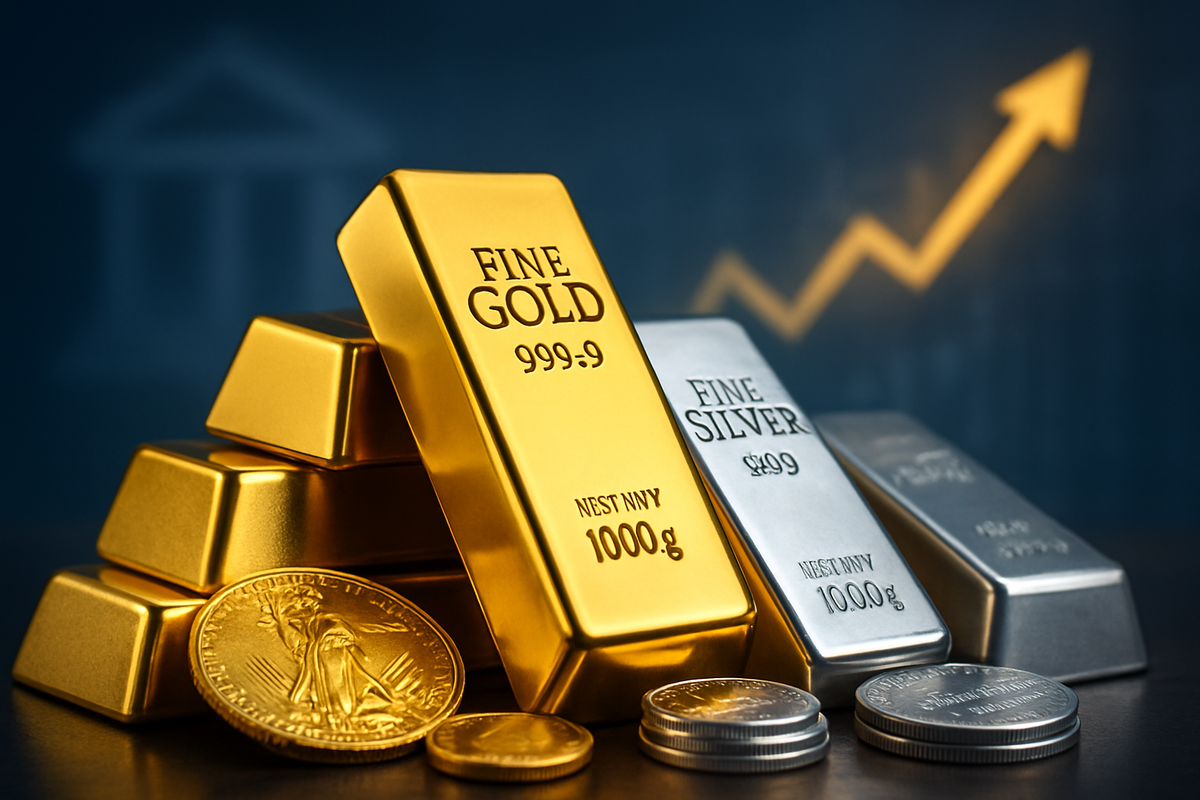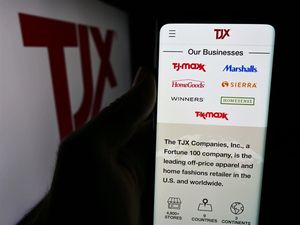
In a dynamic turn of events in November 2025, gold and silver prices have surged, with silver achieving a historic all-time high, as market participants navigate a complex landscape shaped by the Federal Reserve's evolving interest rate policy and a significant uptick in the U.S. jobless rate. This rally underscores precious metals' enduring appeal as safe-haven assets amidst economic uncertainty and signals a potential recalibration of investor portfolios in anticipation of future monetary policy shifts.
The precious metals market has been a focal point of financial news, demonstrating remarkable resilience and growth. Gold prices have comfortably held above the $4,000 per troy ounce mark in international markets, following a steep ascent throughout 2025 that saw it reach an all-time high of $4381.58 in October. Silver, often seen as gold's more volatile counterpart, has truly stolen the spotlight, achieving an unprecedented all-time high of $54.42 per troy ounce on November 14, 2025. This meteoric rise, representing a 65.83% increase year-over-year and a 4.67% jump in the past month, has been fueled by a confluence of structural supply deficits, accelerating industrial demand, and heightened geopolitical uncertainty. The Federal Reserve's monetary policy, marked by a series of rate cuts in 2024 and an additional 25 basis point reduction in October 2025, has played a pivotal role. However, the enthusiasm for further rate cuts in December has waned significantly, with market expectations plummeting from 70-95% to 30-50% by mid-November, largely due to more hawkish commentary from Fed officials and robust economic data. Simultaneously, the U.S. labor market has shown signs of weakening, with the unemployment rate climbing to a four-year high of 4.4% in September 2025, accompanied by an unexpected increase in initial jobless claims. This weakening labor market, while a concern for the broader economy, is paradoxically being interpreted by some investors as a signal for a potentially more dovish Fed policy in the future, thus boosting the appeal of non-yielding assets like gold and silver.
The Dual Impact: Monetary Policy and Labor Market Weakness
The current rally in gold and silver is a direct consequence of the intricate interplay between the Federal Reserve's monetary policy decisions and the evolving state of the U.S. labor market. Following a period of aggressive interest rate hikes from early 2022 to mid-2023 to combat soaring inflation, the Fed initiated a series of rate cuts in 2024, continuing into 2025, bringing the federal funds rate target range to 3.75%-4.00% in October. These cuts initially provided a tailwind for precious metals, reducing the opportunity cost of holding non-yielding assets. However, recent hawkish rhetoric from Fed officials, coupled with the resolution of a government shutdown and stronger-than-expected economic data, has tempered expectations for further rate cuts in December.
Yet, this dynamic is complicated by the recent deterioration in the U.S. labor market. The unemployment rate's rise to 4.4% in September 2025, a four-year high, along with an unexpected increase in initial and continuing jobless claims, has introduced a new variable into the Fed's decision-making calculus. While a weakening labor market signals broader economic softness, it also often paves the way for a more dovish stance from the Federal Reserve, increasing the likelihood of future rate cuts to stimulate economic growth. This perception has provided a fresh impetus for gold and silver, as investors anticipate that the Fed might prioritize supporting the labor market over maintaining a strictly hawkish stance. The initial market reaction saw some downward pressure on precious metals due to the "higher-for-longer" narrative, but the subsequent release of unemployment figures led to a rebound, as the weakening labor market was interpreted as a potential catalyst for future dovish Fed policy. Key players in this scenario include the Federal Reserve, whose pronouncements are closely scrutinized, and investors, who are constantly recalibrating their portfolios in response to economic indicators and policy expectations. Additionally, the industrial demand for silver, driven by its increasing use in solar panels and electric vehicles, has become a significant structural factor supporting its price surge, independent of monetary policy.
Corporate Fortunes Tied to Precious Metals' Ascent
The sustained rally in gold and silver prices presents a clear delineation of winners and losers within the public company landscape, particularly impacting the mining sector.
Winners: Leading gold and silver mining companies are the most direct beneficiaries of this price surge. For instance, Barrick Gold Corporation (NYSE: GOLD), one of the world's largest gold mining companies, and Newmont Corporation (NYSE: NEM), another major player in gold production, stand to see substantial increases in their revenues and profitability. Higher commodity prices directly translate to fatter margins on every ounce of gold or silver they extract. Their stock prices are likely to reflect this improved financial outlook, attracting more investor interest. Similarly, companies focused on silver mining, such as Pan American Silver Corp. (NASDAQ: PAAS) and First Majestic Silver Corp. (NYSE: AG), will experience a significant boost. The all-time high in silver prices is particularly advantageous for these companies, potentially leading to increased exploration budgets and accelerated production to capitalize on the favorable market conditions. Furthermore, companies that provide services or equipment to the mining industry, while not directly producing the metals, could also see increased demand for their offerings as miners ramp up operations.
Potential Losers (Indirectly): While not direct "losers" in the traditional sense, some sectors might face indirect challenges. Industries that rely heavily on stable commodity prices for their input costs, or those that thrive in a consistently strong economic environment with predictable interest rates, might find the current volatility and the implications of a weakening labor market less favorable. For example, some manufacturing sectors that use silver as an industrial component might see their input costs rise, potentially squeezing their profit margins if they cannot pass on these costs to consumers. Additionally, if the flight to safe-haven assets like gold and silver signals broader economic apprehension, companies that are highly cyclical or sensitive to consumer spending could face headwinds. However, the primary impact of this specific event is overwhelmingly positive for the precious metals mining industry.
Broader Economic Implications and Historical Context
The rally in gold and silver, driven by the Federal Reserve's nuanced stance and a four-year high in the jobless rate, carries significant wider implications for the global economy and financial markets. This event is not an isolated incident but rather fits into broader industry trends marked by persistent inflation, geopolitical uncertainties, and a global quest for stable assets.
One of the most significant broader trends is the inflationary environment. While inflation has receded from its 2022 peak, it remains above the Fed's 2% target. Gold and silver have historically served as excellent hedges against inflation, preserving purchasing power when traditional currencies lose value. The current rally reinforces this role, as investors seek refuge from the erosion of value in fiat money. Moreover, geopolitical tensions continue to simmer globally, contributing to market volatility and uncertainty. In such an environment, precious metals are often seen as a universal store of value, independent of any single nation's economic or political stability. The increasing industrial demand for silver, particularly in green technologies like solar panels and electric vehicles, represents a structural shift that provides a strong underlying support for its price, distinguishing its current rally from purely speculative movements.
The ripple effects extend beyond the precious metals market. A sustained rally in gold and silver could divert investment capital from other asset classes, potentially impacting equity markets or other commodities. It also signals a lack of confidence in traditional economic indicators and a potential shift towards more defensive investment strategies. From a regulatory and policy standpoint, the Fed faces a delicate balancing act. The rising jobless rate puts pressure on the central bank to adopt a more accommodative monetary policy to support employment, while persistent inflation argues for a more hawkish stance. This internal conflict within the Fed creates uncertainty and fuels the appeal of precious metals as a hedge against policy missteps. Historically, periods of economic uncertainty, high inflation, or geopolitical instability have often coincided with strong performance in gold and silver. For instance, the surge in gold prices during the 2008 financial crisis and the early days of the COVID-19 pandemic serve as compelling precedents, highlighting their role as safe-haven assets during times of crisis. The current situation, with its blend of labor market weakness and lingering inflation, presents a unique but historically resonant environment for precious metals to thrive.
The Path Forward: Scenarios and Strategic Adaptations
Looking ahead, the trajectory of gold and silver prices will largely hinge on the Federal Reserve's future monetary policy decisions and the evolving health of the U.S. labor market. Several scenarios could unfold, each presenting distinct opportunities and challenges for investors and companies.
In the short-term, the market will closely watch the Fed's December meeting and subsequent statements for any definitive signals regarding interest rate adjustments. If the weakening labor market prompts the Fed to adopt a more dovish stance, potentially signaling further rate cuts in early 2026, gold and silver could experience additional upward momentum. Conversely, if the Fed maintains a "higher-for-longer" approach due to persistent inflation or stronger-than-expected economic data, precious metals might face some downward pressure as the opportunity cost of holding them increases. However, the underlying structural demand for silver, particularly from industrial applications, is likely to provide a floor for its price, even in a less accommodative monetary environment.
In the long-term, the outlook for gold and silver remains robust, especially if global economic uncertainties, geopolitical tensions, and inflationary pressures persist. Precious metals are likely to retain their appeal as a hedge against systemic risks and a store of value. Companies in the mining sector will need to consider strategic pivots and adaptations. This could include increasing exploration and development efforts to expand reserves, optimizing production costs to maximize profitability at higher prices, and potentially engaging in hedging strategies to lock in favorable prices. For investors, this environment presents both opportunities and challenges. The opportunity lies in capitalizing on the continued appreciation of precious metals, potentially through direct investments in physical gold and silver, or through exchange-traded funds (ETFs) and mining stocks. The challenge will be navigating the volatility driven by shifting Fed rhetoric and economic data, requiring a disciplined approach and a keen understanding of market fundamentals. Potential scenarios include a sustained bull market for precious metals if the Fed is forced into deeper rate cuts, or a more range-bound trading environment if economic conditions stabilize. Investors should also consider the potential for increased regulatory scrutiny on commodity markets if prices continue their rapid ascent.
Wrapping Up: Key Takeaways and Investor Outlook
The recent rally in gold and silver prices, culminating in silver's all-time high, stands as a testament to the complex interplay of monetary policy, labor market dynamics, and underlying structural demand. The primary takeaway is the enduring role of precious metals as safe-haven assets, particularly during periods of economic uncertainty and shifting central bank strategies.
Moving forward, the market will remain highly sensitive to pronouncements from the Federal Reserve. The balancing act between addressing persistent inflation and supporting a weakening labor market will dictate the pace and direction of interest rate adjustments, which in turn will significantly influence investor sentiment towards non-yielding assets. The fact that the jobless rate hitting a four-year high is being interpreted as a potential catalyst for dovish Fed policy underscores the market's current focus on future rate cuts.
For investors, the coming months will require vigilance. Key indicators to watch include:
- Federal Reserve announcements and minutes: Any hints regarding future interest rate policy will be paramount.
- Inflation data: Continued elevated inflation will bolster the appeal of precious metals as a hedge.
- Labor market reports: Further weakening in employment figures could reinforce expectations of a more dovish Fed.
- Geopolitical developments: Escalating global tensions will likely continue to drive safe-haven demand.
- Industrial demand for silver: Monitoring growth in sectors like solar and electric vehicles will be crucial for silver's long-term trajectory.
Ultimately, the current rally highlights the importance of diversification in investor portfolios. While the short-term outlook may present volatility, the long-term fundamentals supporting gold and silver, particularly silver's growing industrial applications and both metals' role as hedges against inflation and uncertainty, suggest their continued significance in the financial landscape.
This content is intended for informational purposes only and is not financial advice






